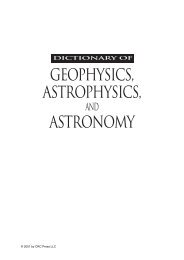tc dokuz eylül university institute of social sciences translation and ...
tc dokuz eylül university institute of social sciences translation and ...
tc dokuz eylül university institute of social sciences translation and ...
You also want an ePaper? Increase the reach of your titles
YUMPU automatically turns print PDFs into web optimized ePapers that Google loves.
wordplay the mere nearness <strong>of</strong> the pun components may be enough to form a<br />
semantic confrontation. Also grammatical <strong>and</strong> other devices are usually used to<br />
emphasize the pun. In vertical wordplay only one component <strong>of</strong> the pun is visible<br />
while the other meaning is hidden <strong>and</strong> materially not in the text; so it has to be<br />
incited into semantic action by contextual constraints. In cases where there is no pun,<br />
one looks for contextual clues to remove ‘irrelevant’ associations, trying to find<br />
single <strong>and</strong> coherent interpretations. However, when a vertical pun is the case, there is<br />
a double context that excludes this disambiguating mechanism <strong>and</strong> requires double<br />
reading. (Delabastita, 1996; 129).<br />
Having listed different types or forms <strong>of</strong> pun, it can be said that;<br />
Punning is possible in any language ins<strong>of</strong>ar as it seems to be<br />
a universal feature <strong>of</strong> language to have words with more than<br />
one meaning (polysemy), different words with the same<br />
spelling or pronunciation (homographs <strong>and</strong> homophones),<br />
<strong>and</strong> words which are synonyms or near-synonyms while<br />
having different pragmatic meanings <strong>and</strong> evoking different<br />
associations. These features all exemplify the basic<br />
asymmetry between language <strong>and</strong> the extra-linguistic world<br />
it is used to denote: languages cannot be <strong>and</strong> are not expected<br />
to provide a separate sign for every single object or event in<br />
the extra-linguistic world. If a language is capable <strong>of</strong> such<br />
one-to-one correspondence with the world existed, it would<br />
be an extremely unwieldy <strong>and</strong> inefficient instrument <strong>of</strong><br />
communication, <strong>and</strong> an impossible one to learn in the first<br />
place. Therefore, language works with a relatively small<br />
repertory <strong>of</strong> signs (e.g. phonemes <strong>and</strong> words) that can<br />
however be combined in a multitude <strong>of</strong> ways to reflect the<br />
complexity <strong>of</strong> reality. (Alexieva, 1997; 138-139).<br />
What is the function <strong>of</strong> a pun? It obviously functions within a context <strong>and</strong><br />
contexts are verbal or situational. When it is verbal, a pun is expected to be<br />
grammatically <strong>and</strong> syntactically well-formed. Also, the established language<br />
components may function contextually such as collocations, proverbs, titles,<br />
basically the phrases which are generally used together. On the other h<strong>and</strong>, in<br />
situational contexts puns function usually in dialogue situations <strong>and</strong> in multimedia<br />
texts, where the visual image in punning advertisements, cartoons or comic strips<br />
activate a secondary meaning <strong>of</strong> the accompanying verbal text. Besides these, puns<br />
function to add to the thematic coherence <strong>of</strong> the text, to produce humor, to force the<br />
12
















